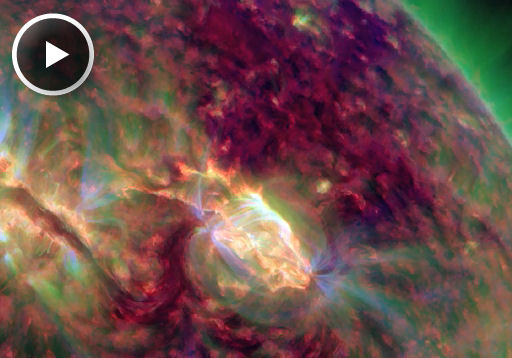BEST NIGHT IN APRIL FOR STARGAZING: If you have to pick just one night in April to go out and look at the stars, a NASA scientist says it should be April 21st. This week's ScienceCast explains what makes that one night so special: video.
THREE EXPLOSIONS: Three coronal mass ejections (CMEs) blasted away from the sun in quick succession during the late hours of April 5th: movie. The clouds were propelled by magnetic filaments erupting in various locations around the sun's northern hemisphere. NASA's Solar Dynamics Observatory recorded this explosion, the most potent of the three:
The movie shows a filament connected to sunspot AR1450 rising up and snapping. In the aftermath of the eruption, an arcade of hot-glowing magnetic loops forms over the blast site as a "canyon of fire" illuminates the empty filament channel.
Remarkably, given their number, not one of the CMEs appears to be heading for our planet. This conclusion is only tentative, however, because of visual confusion among the three clouds. Stay tuned for updates.

Solar wind
speed: 344.9 km/sec
density: 7.4 protons/cm3
explanation | more data
Updated: Today at 1635 UT
X-ray Solar Flares
6-hr max: B2 1529 UT Apr06
24-hr: C1 0000 UT Apr06
explanation | more data
Updated: Today at: 1600 UT
![]()
Daily Sun: 06 Apr 12
With only one significant spot on the Earthside of the sun, solar activity is low. Credit: SDO/HMI
![]()
Sunspot number: 50
What is the sunspot number?
Updated 035 Apr 2012
Spotless Days
Current Stretch: 0 days
2012 total: 0 days (0%)
2011 total: 2 days (<1%)
2010 total: 51 days (14%)
2009 total: 260 days (71%)
Since 2004: 821 days
Typical Solar Min: 486 days
Updated 05 Apr 2012
The Radio Sun
10.7 cm flux: 101 sfu
explanation | more data
Updated 05 Apr 2012
![]()
Current Auroral Oval:
Switch to: Europe, USA, New Zealand, Antarctica
Credit: NOAA/POES
![]()
Planetary K-index
Now: Kp= 1 quiet
24-hr max: Kp= 2 quiet
explanation | more data
Interplanetary Mag. Field
Btotal: 11.5 nT
Bz: 5.2 nT north
explanation | more data
Updated: Today at 1637 UT
![]()
Coronal Holes: 06 Apr 12
A wide equatorial coronal hole is turning toward Earth. Solar wind flowing from the dark gash should arrive on April 12-13. Credit: SDO/AIA.




